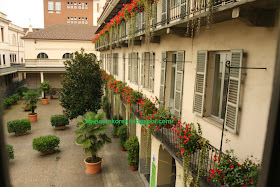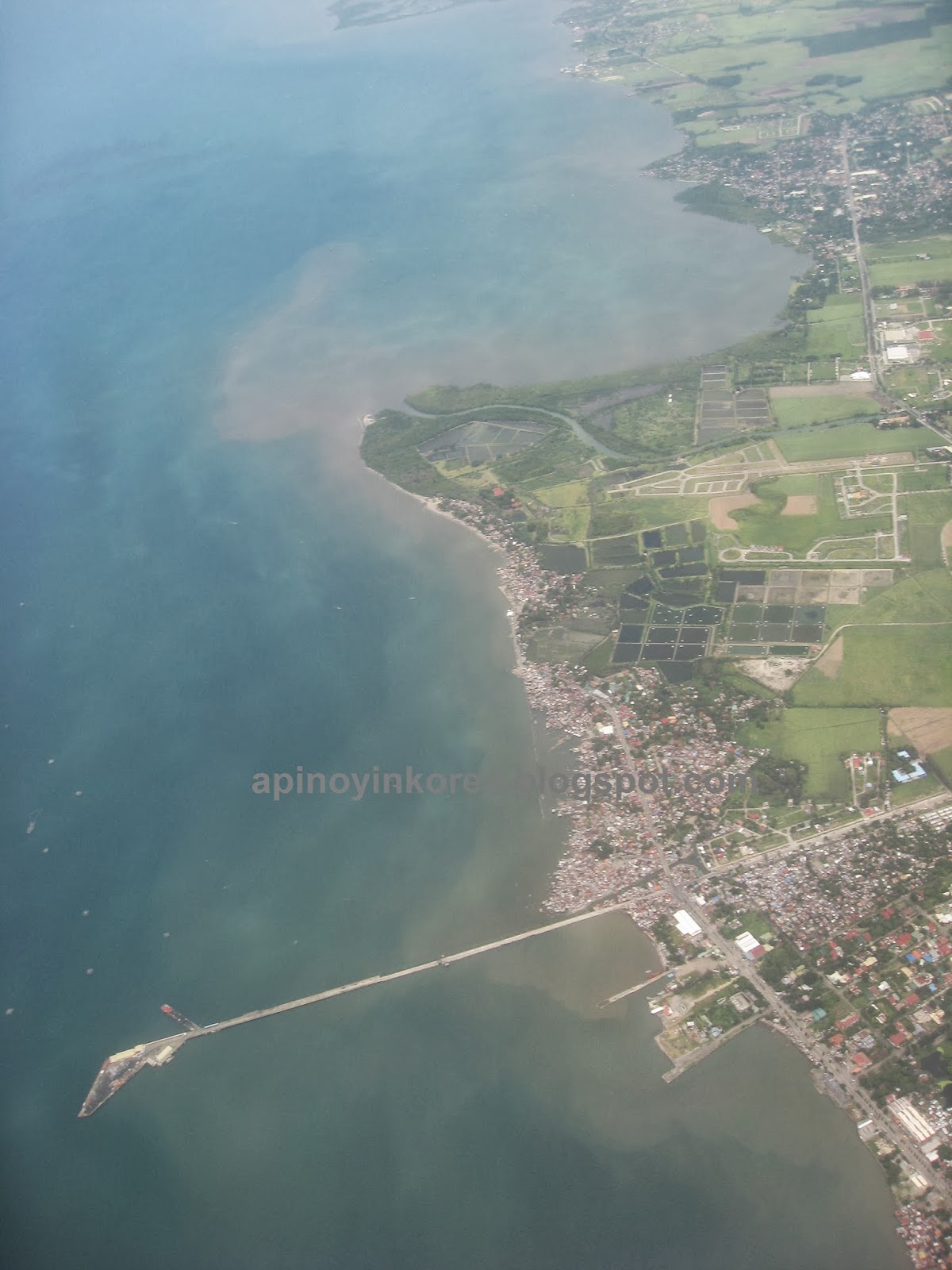Yes, I spent my formative years in Salesian schools. I learned my ABC's at St. Mary Mazarello School, and more difficult words at Don Bosco Technical Institute at Victorias. 😀 I have always credited my Bosconian years for much of what I know today, including singing and praying. One can learn a lot from studying well during grade school and high school, actually.
Saint John Bosco was an Italian saint who looked after the welfare of the youth during his time. He founded the Salesians of Don Bosco based on the philosophy of Saint Francis of Sales, and he died on January 31, 1888. Today is his feast day and Bosconians all over the world are celebrating it. At least one in Korea is.
(The Bosconian headquarters at
Don Bosco Valdocco in Turin, Italy)
(The statues on top of the Basilica of
Mary, Help of Christians)
Don Bosco and those who worked with him made sure the youth whom they looked after were doing something during their waking hours, leaving no time wasted. From praying upon waking up, to studying during the day, to playing during break time and more studying at night.
During my days at school, even during the one-hour lunchtime, there was always volleyball and football. And since football was all about running under the noontime sun, you can just imagine how the classroom would smell like during the first class in the afternoon.
(Basilica di Maria Ausiliatrice at Don Bosco Valdocco)
And over the years, my classmates and I learned about Don Bosco's life and how he even inspired those around him. St. Mary Mazarello worked with him and Saint Dominic Savio was a student.
When I was still a student, we learned that Don Bosco's main headquarters are in Turin, Italy, and that the photograph we saw of the Virgin Mary as the Mary, Help of Christians is actually of the basilica's altar built in her honor.
(Pizza available at the Don Bosco cafeteria)
So, when I visited my friends Maurizio and Margarita in Rome, Italy, I planned a side trip to Turin to visit the basilica built in her honor and the first Bosconian school.
Taking the Trenitalia train from Roma Termini, I arrived in Torino without any map of Turin! I looked for their tourist information center at the train station, but I wasn't able to find it. Luckily, I was able to recall the map I saw on the Internet when I was researching about Turin, and simply walked from the Termini to Corso Stati Uniti, a street, to find the Hotel Italia, where, upon walking in, I confidently declared, "Buon giorno! Ho prenotazione!" The signora at the front desk then asked for my identification.
(Photo of the old cafeteria hanging
inside the cafeteria)
(It was past noon, yet the cafeteria was still busy)
(An old photo of the students inside the old cafeteria.
I wonder how it was like eating Italian food every day at school.😃)
(Don Bosco's bedroom where he died)
The basilica was open when I got there. And the experience of setting foot at the basilica was dream-like. I could not believe I was sitting on a pew in front of an altar which I only saw in photographs when I was still a student. I had to say a prayer of thanks for somebody up there who led me here at the very place founded by the saint whose school in the Philippines taught me most of what I knew today.
(Don Bosco's pictures at his museum)
(The altar where he used to say Mass)
I got there noontime, but I was still able to catch a Mass at the school's chapel of Saint Francis together with grade school kids and their Italian teachers. I had to ask the teacher, "Signora, es la Misa en Italiano?" She politely said, "Si." Of course, it should be in Italian! Although I knew it was, I just had to practice a new language I learned on the nine-hour plane ride from Incheon International Airport to my stopover at the Dubai International Airport.
After the Mass, I walked around and saw the school cafeteria which was serving lunch. I went in and ordered what appealed to my appetite! Actually, everything appealed because it was all Italian food! I ordered pasta and pizza, of course!
(Don Bosco and his students in
a very old photograph)
(Don Bosco's cassock and sticks)
(Saint Mary Mazarello's painting at the museum)
And while I was having lunch, I noticed another guy at the next table. He, too, had a map of Turin! Another tourist like I was! And since everyone else having lunch at the cafeteria was either a student or a teacher (who were all speaking Italian, of course!), we were the odd men out, I thought. Right there, at a cafeteria which has fed thousands of Bosconians for maybe a hundred years, Michele and I became friends. He was also a Bosconian and was from the city of Ravenna of the Emiglia-Romagna region of Italy.
was a mesmerizing experience)
(The basilica's ceiling with paintings)
As Michele had to visit the Olympic Stadium of Turin, I visited the Camarette di Don Bosco, his room and museum, and walked through the quiet hallways alone. I could not believe I was right there at the room where the saint died and where he said Mass. His cassock and his personal things were on display, even his funeral carriage was there.
Photographs and paintings of Don Bosco, Saint Mary Mazarello, Mama Margherita, Don Bosco's mother, and other Bosconian martyrs were on display. It was actually too difficult to take all these history and holiness all in. It was overwhelming. But overwhelming or not, I had to remember that I was very lucky to have set foot in this place in my lifetime.
(The basilica has an altar for St. Mary Mazarello with her incorrupted body on display)
(Also an altar for Saint Dominic Savio)
(A copy of the Shroud of Turin
on display at the basilica)
After the museum, I went back to the Basilica di Maria Ausiliatrice and walked around this time, saying a prayer at the altars of Saint Mary Mazarello and Saint Dominic Savio, and admiring the huge paintings at the ceiling dome.
And from the back of the basilica, I gazed at the altar with the painting of Mary, Help of Christians with the saints around her, and just admire this glorious work of art just like during my student days. But this time, I wasn't just admiring a photograph; I was right in front of the original painting done by Lorenzone as commissioned and describe by Don Bosco from a vision he had seen.
(School grounds)
Walking through the grounds of the Don Bosco motherhouse in Turin, Italy, is one of the trips I will never forget. The Bosconian teachings and spirituality have started in this part of the world, and what was one holy man's vision for the youth has now spread all over the world, molding the minds and the lives of the young.
Michele is back at his hometown in eastern Italy, while I am back in Asia. But just like any Bosconian, we both felt at home and at awe at this place, where our founder lived, taught, and continues to be sanctified.
(From the balcony of Camarette di Don Bosco)
(The dome of the basilica as I saw from the museum area)
(A visiting Bosconian)
(In front of the museum building are flags of some countries where Don Bosco schools are located. The signora at the museum told me that they changed the flags every now and then after I asked her about the Philippine flag, which was not on display.)
(The basilica bathed with lights at night,
looking more beautiful)
So, to all Bosconians in the Philippines, in Italy and all over the world, happy Don Bosco feast day!






















































